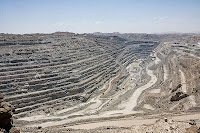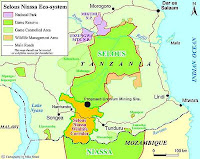The United States is the world's largest consumer of uranium for domestic power production, generating around 19% of its electricity supply at uranium-fueled nuclear power stations. However the nation has limited uranium resources of its own, and is obliged to obtain 90% of the uranium it uses from overseas.The potential for the use of uranium in the production of nuclear weapons meant that uranium reserves were extensively searched for (and exploited) during the Cold War, with the effect that the discovery of new uranium sources is rare today.
In a report published on 2 December 2015, Mark Mihalasky, Susan Hall, Jane Hammarstrom, Kathleen Tureck, Mark Hannon, George Breit, and Robert Zielinski of the United States Geological Survey and Brent Elliott of the Texas Bureau of Economic Geology examine the potential uranium resources of the South Texas Coastal Plain in order to assess the possibility of undiscovered uranium being present in the area.
The presence of uranium, in the form of uranium oxide, in the area is well documented, with numerous uranium mines operating in the area. The uranium is hosted within fluvial (riverbed) and occasionally shallow marine sandstone units within the Eocene Claiborne and Jackson Groups, the Oligocene Catahoula Formation, the Miocene Oakville Sandstone, the Pliocene Goliad Sand and Willis Formation, and the Pleistocene Lissie Formation. This is common with heavy metal deposits, where ore minerals that are present at very low concentrations in other rocks are concentrated in ancient riverbeds by water erosion and subsequently deposited at quiet points on the river. Because the usable ore deposits are concentrated in sections of ancient riverbeds, the workable beds tend to be quite small, narrow and long, at most only a few meters wide and meters to kilometers in length.
Generalized geologic map of the southern Texas Coastal Plain showing operating mines and known uranium occurrences symbolized by their host geologic unit (color) and type (size and shape). Deposits represent mineral sites with recorded uranium production and (or) identified resources. Other types of uranium occurrences include prospects (sites that have some level of exploration), showings (sites of interest that have been recorded), and anomalies (sites with indications that mineralizing processes may have taken place). The region is subdivided by the San Marcos Arch, a broad southeast-trending geologic feature that influenced the deposition and subsequent subsidence of Jurassic through Miocene strata. Mihalasky et al. (2015).
There are at least 169 known uranium-producing sites on the South Texas Coastal Plain, deposits that have to date produced about 36 740 metric tonnes of uranium oxide, with known reserves of about 26 760 tonnes. Most of the uranium oxide extracted to date has been recovered from depths of less than 800 m, though there are known deposits at depths of greater than 1200 m which are considered economically viable.
Mihalasky et al. examined known uranium oxide-producing tracts on the South Texas Coastal Plain down to a depth of 1500 m, using a computer model to extrapolate the number and extent of ore-bearing deposits in unexplored areas, based upon the known distribution of ore bodies in explored areas.
Based upon this they estimate that the area hosts about 99 970 tonnes of undiscovered, recoverable uranium oxide, equivalent to 1.6 times the total uranium oxide previously identified in the area (extracted and unextracted). The majority of this ore (about 90 720 tonnes) is estimated to be in the Rio Grande Embayment, with about 9250 tonnes in the Houston Embayment.
In 2014 nuclear energy producers in the US purchased about 24 000 tonnes of uranium oxide, roughly equivalent to the total known reserves on the South Texas Coastal Plain. The estimated undiscovered reserves that Mihalasky et al.predict are equivalent to about another four years use, suggesting that the area hosts a total amount of uranium sufficient to supply US domestic consumption for five years.
See also...
 Workers injured in incident at Namibian uranium mine. A number of workers are reported to have been treated for minor injuries following an incident at the Rio Tinto operated Rössing Uranium Mine in western Namibia on Tuesday 3 December 2013. The injuries...
Workers injured in incident at Namibian uranium mine. A number of workers are reported to have been treated for minor injuries following an incident at the Rio Tinto operated Rössing Uranium Mine in western Namibia on Tuesday 3 December 2013. The injuries... Uranium mine in northern Niger attacked by suicide bomber. Thirteen workers at uranium mine operated by French company Areva were injured when the site was attacked by a suicide bomber on Thursday
23...
Uranium mine in northern Niger attacked by suicide bomber. Thirteen workers at uranium mine operated by French company Areva were injured when the site was attacked by a suicide bomber on Thursday
23... Uranium mining to begin in Tanzania. A uranium mining project at Mkuju River has been granted a license by the Tanzanian Ministry of Energy and Mineral Resources,
despite widespread opposition within the country. The license has been
granted to Mantra Tanzania, a subsidiary of the Australian Mantra Resources, which is itself owned...
Uranium mining to begin in Tanzania. A uranium mining project at Mkuju River has been granted a license by the Tanzanian Ministry of Energy and Mineral Resources,
despite widespread opposition within the country. The license has been
granted to Mantra Tanzania, a subsidiary of the Australian Mantra Resources, which is itself owned...
Follow Sciency Thoughts on Facebook.

